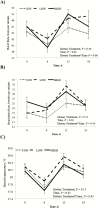Evaluation of conjugated linoleic acid supplementation on markers of joint inflammation and cartilage metabolism in young horses challenged with lipopolysaccharide
- PMID: 29385470
- PMCID: PMC6140902
- DOI: 10.1093/jas/skx076
Evaluation of conjugated linoleic acid supplementation on markers of joint inflammation and cartilage metabolism in young horses challenged with lipopolysaccharide
Abstract
Seventeen yearling Quarter Horses were used in a randomized complete block design for a 56-d trial to determine ability of dietary CLA to mitigate joint inflammation and alter cartilage turnover following an inflammatory insult. Horses were blocked by age, sex, and BW, and randomly assigned to dietary treatments consisting of commercial concentrate offered at 1% BW (as-fed) supplemented with either 1% soybean oil (CON; n = 6), 0.5% soybean oil and 0.5% CLA (LOW; n = 5; 55% purity; Lutalin, BASF Corp., Florham Park, NJ), or 1% CLA (HIGH; n = 6) top-dressed daily. Horses were fed individually every 12 h and offered 1% BW (as-fed) coastal bermudagrass (Cynodon dactylon) hay daily. This study was performed in 2 phases: phase I (d 0 to d 41) determined incorporation of CLA into plasma and synovial fluid; phase II (d 42 to d 56) evaluated potential of CLA to mitigate intra-articular inflammation and alter cartilage metabolism. Blood and synovial fluid were collected at 7- and 14-d intervals, respectively, to determine fatty acid concentrations. On d 42, carpal joints within each horse were randomly assigned to receive intra-articular injections of 0.5 ng lipopolysaccharide (LPS) derived from Escherichia coli 055:B5 or sterile lactated Ringer's solution. Synovial fluid samples were obtained at preinjection h 0 and 6, 12, 24, 168, and 336 h postinjection, and analyzed for prostaglandin E2 (PGE2), carboxypeptide of type II collagen (CPII), and collagenase cleavage neopeptide (C2C). Data were analyzed using PROC MIXED procedure of SAS. Horses receiving the CON diet had undetectable levels of CLA for the duration of the study. A quadratic dose response was observed in concentrations of CLA in plasma and synovial fluid (P < 0.01). A negative quadratic dose response was observed for plasma arachidonic acid (20:4) with a reduction in concentration to d 14 in HIGH horses (P = 0.04). Synovial fluid 20:4 tended to decrease in horses receiving the HIGH diet (P = 0.06). Post LPS injection, synovial PGE2 was not affected by dietary treatment (P = 0.15). Synovial C2C was lower in HIGH horses (P = 0.05), and synovial CPII tended to be greater in LOW horses than HIGH and CON horses (P = 0.10). In conclusion, dietary CLA incorporated into plasma and synovial fluid prior to LPS challenge. Dietary CLA did not influence inflammation; however, there was a reduction in cartilage degradation and an increase in cartilage regeneration.
Figures






Similar articles
-
Influence of oral glucosamine supplementation in young horses challenged with intra-articular lipopolysaccharide.J Anim Sci. 2016 Aug;94(8):3294-3302. doi: 10.2527/jas.2016-0343. J Anim Sci. 2016. PMID: 27695773
-
Responses to an intra-articular lipopolysaccharide challenge following dietary supplementation of Saccharomyces cerevisiae fermentation product in young horses.J Anim Sci. 2021 Oct 1;99(10):skab272. doi: 10.1093/jas/skab272. J Anim Sci. 2021. PMID: 34619765 Free PMC article.
-
Influence of an intra-articular lipopolysaccharide challenge on markers of inflammation and cartilage metabolism in young horses.J Anim Sci. 2013 Jun;91(6):2693-9. doi: 10.2527/jas.2012-5981. Epub 2013 Mar 18. J Anim Sci. 2013. PMID: 23508023
-
The effect of conjugated linoleic acid supplementation on oxidative stress markers: A systematic review and meta-analysis of randomized controlled trials.Clin Nutr ESPEN. 2022 Jun;49:121-128. doi: 10.1016/j.clnesp.2022.04.004. Epub 2022 Apr 14. Clin Nutr ESPEN. 2022. PMID: 35623803
-
Conjugated linoleic acid and bone biology.J Am Coll Nutr. 2000 Aug;19(4):478S-486S. doi: 10.1080/07315724.2000.10718951. J Am Coll Nutr. 2000. PMID: 10963468 Review.
Cited by
-
Effect of a dietary nutraceutical "STRUCTURE-Joint" on response of horses to intra-articular challenge with IL-1: implications for tissue adaptation to stress.Transl Anim Sci. 2024 Dec 7;8:txae172. doi: 10.1093/tas/txae172. eCollection 2024. Transl Anim Sci. 2024. PMID: 39713786 Free PMC article.
-
Dietary conjugated linoleic acid supplementation alters skeletal muscle mitochondria and antioxidant status in young horses.J Anim Sci. 2021 Feb 1;99(2):skab037. doi: 10.1093/jas/skab037. J Anim Sci. 2021. PMID: 33539534 Free PMC article.
-
Fatty Acids and Oxylipins in Osteoarthritis and Rheumatoid Arthritis-a Complex Field with Significant Potential for Future Treatments.Curr Rheumatol Rep. 2021 Apr 28;23(6):41. doi: 10.1007/s11926-021-01007-9. Curr Rheumatol Rep. 2021. PMID: 33913032 Free PMC article. Review.
References
-
- Archibeque S. L., Lunt D. K., Gilbert C. D., Tume R. K., and Smith S. B.. 2005. Fatty acid indices of stearoyl-CoA desaturase do not reflect actual stearoyl-CoA desaturase enzyme activities in adipose tissues of beef steers finished with corn-, flaxseed-, or sorghum-based diets. J. Anim. Sci. 83:1153–1166. doi:10.2527/2005.8351153x - PubMed
-
- Battacharya A., Banu J., Rahman M., Causey J., and Fernandes G.. 2006. Biological effects of conjugated linoleic acids in health and disease. J. Nutr. Biochem. 17:789–810. doi:10.1016/j.jnutbio.200602.009 - PubMed
-
- Bertone A. L., Palmer J. L., and Jones J.. 2001. Synovial fluid cytokines and eicosanoids as markers of joint disease in horses. Vet. Surg. 30:528–531. doi:10.1053/jvet.2001.28430 - PubMed
-
- Bliss M. R. 1998. Hyperaemia. J. Tissue Viability. 8:4–13. doi:10.1016/S0965-206x(98)80028-4 - PubMed
-
- Changhua L., Jindong Y., Defa L., Lidan Z., Shiyan Q., and Jianjun X.. 2005. Conjugated linoleic acid attenuates the production and gene expression of proinflammatory cytokines in weaned pigs challenged with lipopolysaccharide. J. Nutr. 135:239–244. - PubMed
MeSH terms
Substances
LinkOut - more resources
Full Text Sources
Other Literature Sources
Medical

